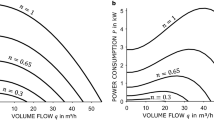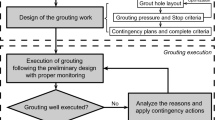Conclusions
Seepage of water through concrete structures has a broad spectrum of pressure and free-flow manifestations, location and the source and outlet, causes of occurrence, and external forms of leaching accompanying it;
On hydraulic structures seepage is local, occurring along defective sections and points of the concrete;
Long-term observations prove the gradual decrease of the seepage rate as a whole for structures of the cascade of Paz hydrostations and the dependence of the character of its variation seasonally on the site of seepage;
Antiseepage measures on operating objects are diverse both with respect to general direction (suppression, diversion, or isolation) and methods of realization. Their selection is determined both by the structural characteristics and purpose of the works (elimination of seepage centers, protection of structures and equipment, cosmetic purposes, provision of safety for the personnel);
New methods of sealing concrete on structures of the cascade were tested: pneumatic injection of dry cement and a solution of colophony in acetone.
Seepage centers in powerhouses and dams occur not only from the head of water but also from the effect of factors common for all construction objects, such as precipitation, groundwaters, leaks from engineering supply lines; the experience in eliminating such centers was not examined in the article;
The increase of the presence of defects as a consequence of the long effect of seepage, even diminishing seepage, and the noted increase of its rate in individual places require an increase of the scope of antiseepage works.
Similar content being viewed by others
Literature cited
Yu. A. Protsenko, “Characteristics of the operation of massive buttress dams under harsh northern conditions,” Gidrotekh. Stroit., No. 9 (1966).
D. M. Yashkul' and V. V. Belov, “Experience in operating overflow buttress dams under harsh climatic conditions,” Gidrotekh. Stroit., No. 8 (1982).
D. M. Yashkul', “Experience in operating the hydraulic structures of the Borisoglebsk hydroelectric station,” Gidrotekh. Stroit., No. 3 (1985).
V. P. Repkin, Maintenance of Hydraulic Structures of Hydroelectric Stations [in Russian], Gosénergoizdat, Moscow (1952).
V. K. Baushev and D. M. Yashkul', Author's Certificate No. 714816, “Method of sealing slits in concrete structures,” Byull. Izobret., No. 41 (1981)
V. K. Baushev et al., “Use of air dispersions of a binder in hydrotechnical construction,” Izv. VNIIG,176 (1984).
V. K. Baushev et al., “Compaction of low-permeability soils and structures,” in: Stabilization and Compaction of soils in Construction [in Russian], Stroiizdat, Moscow (1978).
Additional information
Translated from Gidrotekhnicheskoe Stroitel'stvo, No. 2, pp. 34–39, February, 1993.
Rights and permissions
About this article
Cite this article
Yashkul', D.M. Experience in antiseepage works on concrete structures of the Paz hydroelectric stations. Hydrotechnical Construction 27, 90–98 (1993). https://doi.org/10.1007/BF01545436
Issue Date:
DOI: https://doi.org/10.1007/BF01545436




